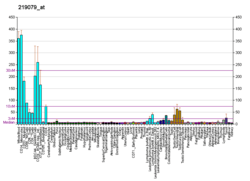CYB5R4
Cytochrome b5 reductase 4 is an enzyme that in humans is encoded by the CYB5R4 gene.[5][6]
NCB5OR is a flavohemoprotein that contains functional domains found in both cytochrome b5 (CYB5; MIM 250790) and CYB5 reductase (DIA1; MIM 250800).[supplied by OMIM][6]
References
- 1 2 3 GRCh38: Ensembl release 89: ENSG00000065615 - Ensembl, May 2017
- 1 2 3 GRCm38: Ensembl release 89: ENSMUSG00000032872 - Ensembl, May 2017
- ↑ "Human PubMed Reference:".
- ↑ "Mouse PubMed Reference:".
- ↑ Zhu H, Qiu H, Yoon HW, Huang S, Bunn HF (Jan 2000). "Identification of a cytochrome b-type NAD(P)H oxidoreductase ubiquitously expressed in human cells". Proc Natl Acad Sci U S A. 96 (26): 14742–7. doi:10.1073/pnas.96.26.14742. PMC 24718. PMID 10611283.
- 1 2 "Entrez Gene: CYB5R4 cytochrome b5 reductase 4".
External links
- Human CYB5R4 genome location and CYB5R4 gene details page in the UCSC Genome Browser.
Further reading
- Hartley JL, Temple GF, Brasch MA (2001). "DNA cloning using in vitro site-specific recombination". Genome Res. 10 (11): 1788–95. doi:10.1101/gr.143000. PMC 310948. PMID 11076863.
- Wiemann S, Weil B, Wellenreuther R, et al. (2001). "Toward a catalog of human genes and proteins: sequencing and analysis of 500 novel complete protein coding human cDNAs". Genome Res. 11 (3): 422–35. doi:10.1101/gr.GR1547R. PMC 311072. PMID 11230166.
- Strausberg RL, Feingold EA, Grouse LH, et al. (2003). "Generation and initial analysis of more than 15,000 full-length human and mouse cDNA sequences". Proc. Natl. Acad. Sci. U.S.A. 99 (26): 16899–903. doi:10.1073/pnas.242603899. PMC 139241. PMID 12477932.
- Zhu H, Larade K, Jackson TA, et al. (2004). "NCB5OR is a novel soluble NAD(P)H reductase localized in the endoplasmic reticulum". J. Biol. Chem. 279 (29): 30316–25. doi:10.1074/jbc.M402664200. PMC 3045664. PMID 15131110.
- Wiemann S, Arlt D, Huber W, et al. (2004). "From ORFeome to biology: a functional genomics pipeline". Genome Res. 14 (10B): 2136–44. doi:10.1101/gr.2576704. PMC 528930. PMID 15489336.
- Andersen G, Wegner L, Rose CS, et al. (2005). "Variation in NCB5OR: studies of relationships to type 2 diabetes, maturity-onset diabetes of the young, and gestational diabetes mellitus". Diabetes. 53 (11): 2992–7. doi:10.2337/diabetes.53.11.2992. PMC 3044473. PMID 15504981.
- Kimura K, Wakamatsu A, Suzuki Y, et al. (2006). "Diversification of transcriptional modulation: large-scale identification and characterization of putative alternative promoters of human genes". Genome Res. 16 (1): 55–65. doi:10.1101/gr.4039406. PMC 1356129. PMID 16344560.
- Mehrle A, Rosenfelder H, Schupp I, et al. (2006). "The LIFEdb database in 2006". Nucleic Acids Res. 34 (Database issue): D415–8. doi:10.1093/nar/gkj139. PMC 1347501. PMID 16381901.
This article is issued from
Wikipedia.
The text is licensed under Creative Commons - Attribution - Sharealike.
Additional terms may apply for the media files.




